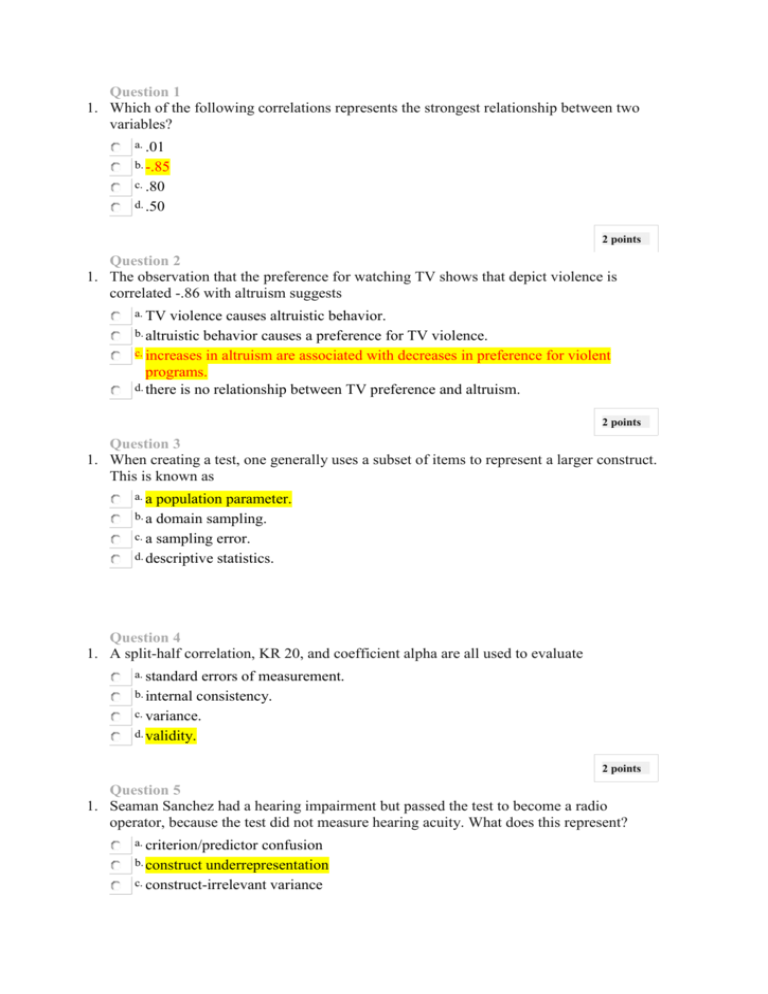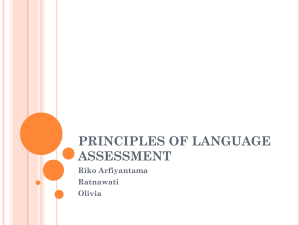Question 1 - s3.amazonaws.com
advertisement

Question 1 1. Which of the following correlations represents the strongest relationship between two variables? a. .01 b. -.85 c. .80 d. .50 2 points Question 2 1. The observation that the preference for watching TV shows that depict violence is correlated -.86 with altruism suggests a. TV violence causes altruistic behavior. b. altruistic behavior causes a preference for TV violence. c. increases in altruism are associated with decreases in preference for violent programs. d. there is no relationship between TV preference and altruism. 2 points Question 3 1. When creating a test, one generally uses a subset of items to represent a larger construct. This is known as a. a population parameter. b. a domain sampling. c. a sampling error. d. descriptive statistics. Question 4 1. A split-half correlation, KR 20, and coefficient alpha are all used to evaluate a. standard errors of measurement. consistency. c. variance. d. validity. b. internal 2 points Question 5 1. Seaman Sanchez had a hearing impairment but passed the test to become a radio operator, because the test did not measure hearing acuity. What does this represent? a. criterion/predictor confusion b. construct underrepresentation c. construct-irrelevant variance d. criterion-related evidence for validity 2 points Question 6 1. Cronbach and other authors have argued that all types of validity are really categories of a. face validity. validity. c. content validity. d. construct validity. b. criterion 2 points Question 7 1. Evidence that indicates a measure does not represent a construct other than the one for which it was devised is ____ validity. a. convergent b. discriminant c. content d. predictive 2 points Question 8 1. Mr. and Mrs. Lozano have recently moved to Ohio from Mexico and have been notified that their son Rueben will be given an English IQ test to determine school placement. They should a. not be concerned about the language of the test because one of the secretaries has offered to translate. b. be pleased because the school is hiring a professional to translate the test especially for Rueben. c. ask the school to only use a test that has been translated and subjected to reliability and validity studies in Spanish speaking populations. d. realize that by testing their son in English they are helping him to acculturate to his new environment much faster. 2 points Question 9 1. The personnel manager of ABC Company asked all of the applicants she interviewed the same questions in the same systematic fashion. She was conducting a(n) ____ interview. a. nondirective b. unstructured c. structured d. diagnostic 2 points Question 10 1. Refer to image for item 10 in the instructions. In terms of criterion validity, the situation shown in this following diagram reflects... a. bias in favor of Group A. b. bias in favor of Group B. c. no bias. d. differential validity. 2 points 1. Question 11 Refer to image for item 11 in the instructions. In terms of criterion validity, the situation shown in the diagram reflects... a. higher validity for Group B. b. test bias in favor of Group B. c. no bias in favor of either group. d. differential validity. 2 points Question 12 1. A test has adverse impact if it a. decreases an individual's self-esteem. b. systematically rejects higher proportions of minority than non-minority individuals. c. prevents non-minority applicants from being hired. d. is used by an untrained administrator. 2 points 1. Question 13 Refer to image for item 13 in the instructions. The combined regression line in the figure ____ predicts Group A and ____ predicts Group B. a. accurately; accurately b. accurately; under c. under; over d. over; under 2 points Question 14 1. ABC Company has received 150 job applicants for a job opening: 100 white applicants, 25 Mexican-Americans, and 25 African-Americans. They hired 60 of the white applicants. How many of the other two groups do they have to hire in order to abide by the four-fifths rule? a. 12 from each group b. a total of 24 in any combination c. 15 from each group d. a total of 30 in any combination 2 points Question 15 1. Suppose you are in the 87th percentile on a test. This means a. you are among the top 13 students in the class. b. 87% of the students got a score lower than yours. c. you got 87% of the test items correct. d. 87% of the students got a score higher than yours. 2 points Question 16 1. Find the standard deviation for the following group of scores: 2, 4, 3, and 7. Blank 1 2.160 3 points Question 17 1. On a measure of anxiety, the mean is 79 and the standard deviation is 12. What is the zscore for an actual score of 68? Blank 1 -0.92 3 points Question 18 1. A psychologist has been studying eye fatigue using a particular measure, which she administers to students after they have worked for 1 hour writing on a computer. On this measure, she has found that the distribution follows a normal curve. Using a normal curve table, what percentage of students have z-scores below 1.5? Blank 1 0.9332 3 points Question 19 1. A psychologist has been studying eye fatigue using a particular measure, which she administers to students after they have worked for 1 hour writing on a computer. On this measure, she has found that the distribution follows a normal curve. The test of eye fatigue has a mean of 15 and a standard deviation of 5. Using a normal curve table, what score on the eye fatigue measure would a person need to have to be in the top 40%? Blank 1 16.27 3 points Question 20 1. X and Y correlate 0.20. What is the coefficient of determination of this relation? Blank 1 0.04 3 points Question 21 1. Identify and describe two (2) factors that affect reliability coefficients. Be sure to define reliability coefficient in your answer before explaining how the two factors affect reliability coefficients. Press Tab to enter the content editor. For the toolbar, press ALT+F10 (PC) or ALT+FN+F10 (Mac). Path: p Words:0 5 points Question 22 1. What is the test-retest method of estimating reliability? Describe the type of study that would be needed to find evidence of test-retest reliability. When is this method best used? When should it not be used? Press Tab to enter the content editor. For the toolbar, press ALT+F10 (PC) or ALT+FN+F10 (Mac). Path: p Words:0 5 points Question 23 1. Fully explain the relationship between reliability and validity. Press Tab to enter the content editor. For the toolbar, press ALT+F10 (PC) or ALT+FN+F10 (Mac). Path: p Words:0 5 points Question 24 1. Identify the steps of a criterion-related validation study. Be sure to define criterionrelated validity in your answer. Press Tab to enter the content editor. For the toolbar, press ALT+F10 (PC) or ALT+FN+F10 (Mac). Path: p Words:0 5 points Question 25 1. Define standard error of measurement. Describe its relationship to confidence intervals (you will need to define confidence intervals in your answer). Answer:- Standard error is determined by dividing standard deviation by the square root of sample size n and it represents the standard deviation of sample mean X-bar. A confidence interval gives us an interval estimation of the population parameter at a given level of confidence percentage. Standard error we use to determine the margin of error that we further add and subtract to the sample mean in order to get the confidence interval limits. Press Tab to enter the content editor. For the toolbar, press ALT+F10 (PC) or ALT+FN+F10 (Mac). Path: p Words:0 5 points Question 26 1. What is restriction of range? What is its effect on the validity coefficient? Provide an example of this concept. Press Tab to enter the content editor. For the toolbar, press ALT+F10 (PC) or ALT+FN+F10 (Mac). Path: p Words:0 5 points Question 27 1. Messick (1995) suggested that the traditional view of construct is fragmented and proposed a unified and expanded concept of construct validity: Briefly describe the problems that he identified with the traditional view of construct validity. (Note that you will first need to briefly describe the traditional view.) Identify and fully describe four (4) of the six aspects of Messick's view of construct validity, that highlight the central issues he identified. Finally, describe Messick s (1995) unified validity framework and its four classification types (i.e., the progressive matrix). Using examples is helpful. Press Tab to enter the content editor. For the toolbar, press ALT+F10 (PC) or ALT+FN+F10 (Mac). Path: p Words:0 25 points Question 28 1. Extra credit: The speedometer on your car is an example of what kind of scale measurement? a. nominal b. ordinal c. interval d. ratio 1 points (Extra Credit) Question 29 1. Extra credit: A Z score of 1.0 is associated with approximately the a. 16th percentile. b. 50th percentile. c. 75th percentile. d. 84th percentile. 1 points (Extra Credit) Question 30 1. Extra credit: In the standard normal distribution, a. most of the scores cluster on the ends of the distribution. b. more scores fall above the mean than below the mean. c. more scores fall below the mean than above the mean. d. approximately 95% of all scores fall between plus and minus two standard deviations from the mean. 1 points (Extra Credit) Question 31 1. Extra credit: Interquartile range is bounded by the a. middle 25% of the distribution. b. top 50% of the distribution. c. middle 50% of the distribution. d. bottom 25% of the distribution. 1 points (Extra Credit) Question 32 1. Extra credit: Suppose that X and Y are uncorrelated. X has a mean of 15 and Y has a mean of 19. Given a score of 14 on a particular X observation, the best prediction of Y is a. 0 b. 15 c. 19 d. indeterminate 2 points (Extra Credit) Question 33 1. Extra credit: The standard deviation of the residuals is called the a. coefficient of alienation b. shrinkage c. coefficient of determination d. standard error of the estimate 3 points (Extra Credit) Question 34 1. Extra credit: For the following situation, consider the type of inference that the test user desires to make from the test score and indicate the type of validation study that would be most appropriate (content, criterion-related predictive, criterion-related concurrent, or construct): An observational rating scale is being developed to rate the classroom performance of first-year teachers, and experienced classroom teachers are asked to examine the items on the rating scale to see if they are relevant to effective performance. Press Tab to enter the content editor. For the toolbar, press ALT+F10 (PC) or ALT+FN+F10 (Mac). -- Font family -- Path: p Words:0 4 points (Extra Credit) Question 35 1. Extra credit: Identify and describe two (2) problems that can affect the results of a criterion-related validity study. Press Tab to enter the content editor. For the toolbar, press ALT+F10 (PC) or ALT+FN+F10 (Mac). Path: p Words:0 5 points (Extra Credit) Question 36 1. Extra credit: Fully define construct-irrelevant variance. Be sure to include the main type of validity it is related to as well its effects on test scores. Incorporate Messick (1995) from your readings into your answer. Press Tab to enter the content editor. For the toolbar, press ALT+F10 (PC) or ALT+FN+F10 (Mac). Path: p Words:0 5 points (Extra Credit) Save and Submit







